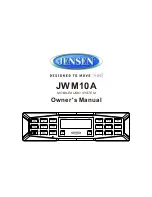
9
What You Can Change:
Options:
Press
Add
in the
START MENU
and follow the voice prompts
to turn an option on.
Press
Delete
in the
START
MENU
to turn an option off.
Option 01 - Panel Beeps
Panel Beeps are any beeps (including chime beeps) that
come from the Control Panel. Panel Beeps, except for
alarm sirens, may be disabled. See “Panel Beeps” on
page 3.
Option 02 - Panel Voice
Panel Voice may be disabled, except for status messages,
open sensor responses, and when in program mode.
Option 03 - Latchkey Time
Adding this option allows you to program Latchkey Time.
Latchkey is used to notify parents if children do not arrive
home at a predetermined time and disarm the system.
Option 36 - Sensor Activated Light Lockout Start Time
Option 37 - Sensor Activated Light Lockout Stop Time
(Not for use with Basic Model)
The Control Panel will not turn on a light which is activated
by a sensor, even if sensor activated lights are enabled,
between the programmed start time (option 36) and the
programmed stop time (option 37).
Both options must be programmed for this feature to work.
The
LIGHTS Sensor Activated
button must be lit for lights
to turn on.
Option 41 - Voice Chime
The Control Panel will verbally announce which chime sen-
sor has been tripped if the chime feature is on.
Option 42 - Speaker Level
(Not for use with Basic Model)
Turn the Control Panel speaker level to the high voice level
when the option is turned on or turn the speaker level to the
low voice level when turned off.
Option 43 - Pager Phone Number
Up to 22 digits, including pauses, may be programmed for
the pager phone number.
Add 3 or 4 pauses to the end of the phone number to
ensure the complete pager message will be received.
Press the
Test
button to program a pause into the phone
number.
The Control Panel will call the pager to indicate:
•
No activity
- The no activity time period is programmed
by your installer. A no activity alarm is called in if the pro-
grammed amount of time passes, the Control Panel is
subdisarmed, disarmed, or doors and windows armed,
and no activity has occurred (a key has not been
pressed or a sensor has not been tripped). Tripping of
non-intrusion chime sensors is not considered activity.
•
Latchkey
- A latchkey report is called when the system
is not disarmed by a predetermined time. The latchkey
time is programmed by the user - Option 03. Latchkey
must be enabled when arming.
•
Phone Test
- A phone test report is called in when a
phone test has been performed.
•
Disarming
- A disarming report is called in when the
system is disarmed. This option is programmed by your
installer.
•
Arming
- An arming report is called in when the system
is armed. This option is programmed by your installer.
•
Fail to Disarm
- A fail to disarm report is called in when
the system is not disarmed by the time programmed by
the installer.
•
Fail to Arm
- A fail to arm report is called in when the
system is not armed by the time programmed by the
installer.
•
AC Power Failures
- An AC power failure is called in 15
minutes after loss of power.
•
AC Power Restoral
- A restoral will be reported when
power is restored.
•
Alarms
- Alarm resports include: Emergency, Intrusion,
and Fire.
Sensor Test
or
Phone Test .
A sensor test or phone
test can be performed by following the instructions given in the
section labeled “Manual Tests--What You Need to Test” on
page 13 of this manual.
Access Codes.
Your security system has a master
access code, access codes 1-5, and a panic code. The mas-
ter code is used for disarming and programming your system.
Access codes 1-5 are generally used for children or as tem-
porary codes for a babysitter or service personnel and may
be used only for disarming. The panic code may be entered
to disarm or subdisarm the system in a non-medical emer-
gency situation. The Control Panel will call the central station,
but there will be no indication of an alarm at the Control
Panel.
Note:
Because different codes can be entered using the
same button presses you have to use caution when program-
ming the panic code. You need to ensure that the panic code
does not use the same button presses as other access
codes. For example if the master code is 1234, do not pro-
gram the panic code to be 2244. The Control Panel would
interpret these codes to be the same code.
Time Activated Lights.
(Not Included in Basic
Model)
Lights may be put on a time schedule.
Entry/Exit Activated Lights.
(Not Included in Basic
Model)
Lights will turn on for the delay period.
Sensor Activated Lights.
(Not Included in Basic
Model)
Lights will turn on for 4 minutes after a sensor is
tripped.
Set Clock.
If the panel loses power, the clock must be set.
House Code.
(Not Included in Basic Model)
The house
code programmed into the panel should match the house
code set on lamp, appliance, and garage door modules.
Programming Your System










































